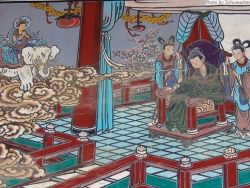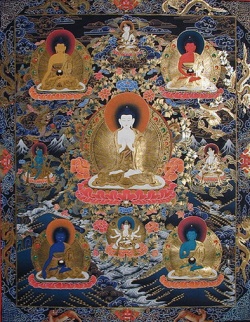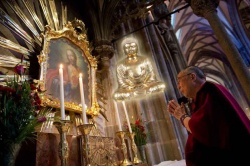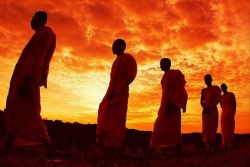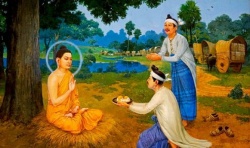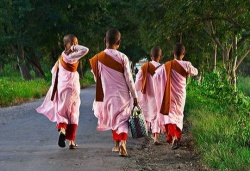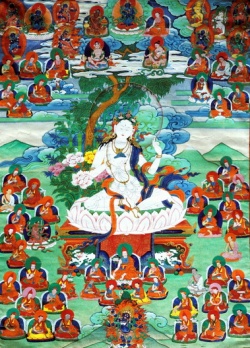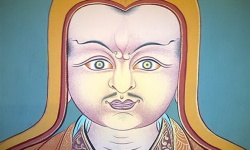Difference between revisions of "Text Analysis of the Union of Sun and Moon Tantra (nyid zla kha sbyor rgyud)from the Tibetan Renaissance Seminar"
| Line 11: | Line 11: | ||
| − | The [[Tantra of the Great Secret Union of the Sun and Moon]] ([[Nyi ma dang zla kha sbyor]]); ([[nyid zla kha sbyor rgyud]]) is one of the [[Seventeen Tantras]] ([[rgyud bcu bdun]]) within the [[Nyingma]] ([[rnying ma]]) school’s [[Seminal Heart]] ([[snying thig]]) [[tradition]]. According to [[Nyingma]] sources, this [[tantra]] was first [[taught]] in [[India]] by [[Garab Dorje]] ([[dga’ rab rdo rje]]), who lived three hundred and sixty years after the [[historical Buddha]], to [[Manjusrimitra]]. Eventually, it was transmitted to [[Tibet]]. The Emporer [[Trisong Detsen]] hid the [[scripture]] in the eighth century, and it was revealed as [[Terma]] ([[gter ma]]), or [[treasure text]], by [[Dangma]] | + | The [[Tantra of the Great Secret Union of the Sun and Moon]] ([[Nyi ma dang zla kha sbyor]]); ([[nyid zla kha sbyor rgyud]]) is one of the [[Seventeen Tantras]] ([[rgyud bcu bdun]]) within the [[Nyingma]] ([[rnying ma]]) school’s [[Seminal Heart]] ([[snying thig]]) [[tradition]]. According to [[Nyingma]] sources, this [[tantra]] was first [[taught]] in [[India]] by [[Garab Dorje]] ([[dga’ rab rdo rje]]), who lived three hundred and sixty years after the [[historical Buddha]], to [[Manjusrimitra]]. Eventually, it was transmitted to [[Tibet]]. The Emporer [[Trisong Detsen]] hid the [[scripture]] in the eighth century, and it was revealed as [[Terma]] ([[gter ma]]), or [[treasure text]], by [[Dangma Lhüngyel]] (Davidson, 230). According to [[Ronald Davidson]], the written version of the [[seventeen tantras]] was most probably a product of the [[Chè]] ([[lce clan]] in the eleventh and twelfth centuries (228). |
| + | |||
| + | The contents of this text deal with the [[teaching]] of the [[bardos]] ([[bar do]]), or [[intermediate states]], that all [[beings]] are [[subject]] to. Although the number of [[intermediate states]] ranges from four to six depending on the source, the [[Tantra]] of the [[Great Secret Union]] of the {{Wiki|Sun}} and [[Moon]] names five: the [[bardo]] | ||
| + | |||
| + | of [[nature]], the [[bardo]] of the [[state of samadhi]], the [[bardo of dream]], the [[bardo of birth and death]], and the [[bardo of existence]]. This [[discussion]] on the [[bardos]] predates the more popularly known treatment of the [[bardos]] in the fourteenth century [[treasure text]], [[Self Liberation Through Hearing]] ([[Bar do thos grol]]) . | ||
| + | |||
| + | |||
| − | |||
[[Character]] | [[Character]] | ||
| + | |||
| + | |||
This [[tantra]] is in [[sangiti]] [[form]], in which the [[buddha]] [[Dorje Chang]] ([[rdo rje chang]], Skt. [[Vajradhara]]) teaches [[esoteric]] [[Buddhist doctrine]] to a [[bodhisattva]] (Orofino, 20). The [[bodhisattva]] in this [[tantra]] is [[Mitog Thuba]] ([[mi rtog thub pa]]) who asks [[Dorje Chang]] a series of questions concerning how [[sentient beings]] can attain [[liberation]] in the various [[intermediate states]]. Most of the text is in verse. | This [[tantra]] is in [[sangiti]] [[form]], in which the [[buddha]] [[Dorje Chang]] ([[rdo rje chang]], Skt. [[Vajradhara]]) teaches [[esoteric]] [[Buddhist doctrine]] to a [[bodhisattva]] (Orofino, 20). The [[bodhisattva]] in this [[tantra]] is [[Mitog Thuba]] ([[mi rtog thub pa]]) who asks [[Dorje Chang]] a series of questions concerning how [[sentient beings]] can attain [[liberation]] in the various [[intermediate states]]. Most of the text is in verse. | ||
| Line 21: | Line 28: | ||
The first section of this text, discussing the [[Bardo of Present Life]] ([[rang bzhin bar do]]) is not available in English translation. It contains detailed explanations of a [[yoga]] system that allows practitioners to control and [[channel]] their [[physical]] and [[mental]] energies towards the goal of [[spiritual]] [[enlightenment]] (Orofino, 20). | The first section of this text, discussing the [[Bardo of Present Life]] ([[rang bzhin bar do]]) is not available in English translation. It contains detailed explanations of a [[yoga]] system that allows practitioners to control and [[channel]] their [[physical]] and [[mental]] energies towards the goal of [[spiritual]] [[enlightenment]] (Orofino, 20). | ||
| − | The second section of the text is devoted to the [[Bardo of Death]] (’[[chi khai’i bar do]]). [[Mitog Thuba]] asks [[Dorje Chang]] to explain the [[signs of death]], and [[methods]] of preventing [[death]] if one sees these [[signs]]. [[Dorje Chang]] discusses various [[signs of death]]. For example, if one’s {{Wiki|nose}} flattens out, he will [[die]] in five days, or, if black spots appear on one’s {{Wiki|tongue}}, he will [[die]] after two days (Orofino 22-23). He goes on to explain [[magical]] [[rituals]] that one can perform to reverse the course of [[death]]. Then, the [[buddha]] in the {{Wiki|dialogue}} suddenly switches from [[Dorje Chang]] to [[Vajrasattva]]. [[Mitog Thuba]] asks [[Vajrasattva]], how one is to [[recognize]] the [[pure]] [[state]] of [[wisdom]] at the [[moment]] of [[death]]. [[Vajrasattva’s]] reply begins with a description of the [[physical]] process of [[death]]: at [[death]], the various [[elements]] of one’s [[body]] dissolve into each other - [[earth]] into [[earth]], [[water]] into [[water]], [[fire]] into [[fire]], and [[air]] into [[air]]. Each of these dissolutions is accompanied by a [[physical]] sign like the cooling of the [[body]] or the stiffening of the limbs. The [[moment]] of [[death]], though, also represents an opportunity to unify one’s [[mind]] with the [[wisdom of the Buddha]], thus achieving [[enlightenment]]. This involves taking the "[[position of the sleeping lion]]," entering into a [[state]] of profound [[meditation]], and then directing the [[mind]] to the [[eyes]]. In a [[moment]] of [[pure]] focus, where [[pure awareness]] is [[concentrated]] into a single point, the [[person]] achieves [[enlightenment]] and does not have to wander in the [[bardo]]. This, however, is a very difficult task to perform. [[Vajrasattva]] outlines particular ways that a [[master]] or [[dharma]] brother can help a dying [[practitioner]] perform this task. | + | The second section of the text is devoted to the [[Bardo of Death]] (’[[chi khai’i bar do]]). [[Mitog Thuba]] asks [[Dorje Chang]] to explain the [[signs of death]], and [[methods]] of preventing [[death]] if one sees these [[signs]]. [[Dorje Chang]] discusses various [[signs of death]]. For example, if one’s {{Wiki|nose}} flattens out, he |
| + | |||
| + | |||
| + | will [[die]] in five days, or, if black spots appear on one’s {{Wiki|tongue}}, he will [[die]] after two days (Orofino 22-23). He goes on to explain [[magical]] [[rituals]] that one can perform to reverse the course of [[death]]. Then, the [[buddha]] in the {{Wiki|dialogue}} suddenly switches from [[Dorje Chang]] to [[Vajrasattva]]. [[Mitog Thuba]] | ||
| + | |||
| + | asks [[Vajrasattva]], how one is to [[recognize]] the [[pure]] [[state]] of [[wisdom]] at the [[moment]] of [[death]]. [[Vajrasattva’s]] reply begins with a description of the [[physical]] process of [[death]]: at [[death]], the various [[elements]] of one’s [[body]] dissolve into each other - [[earth]] into [[earth]], [[water]] into [[water]], [[fire]] | ||
| + | |||
| + | into [[fire]], and [[air]] into [[air]]. Each of these dissolutions is accompanied by a [[physical]] sign like the cooling of the [[body]] or the stiffening of the limbs. The [[moment]] of [[death]], though, also represents an opportunity to unify one’s [[mind]] with the [[wisdom of the Buddha]], thus achieving [[enlightenment]]. This involves | ||
| + | |||
| + | taking the "[[position of the sleeping lion]]," entering into a [[state]] of profound [[meditation]], and then directing the [[mind]] to the [[eyes]]. In a [[moment]] of [[pure]] focus, where [[pure awareness]] is | ||
| + | |||
| + | [[concentrated]] into a single point, the [[person]] achieves [[enlightenment]] and does not have to wander in the [[bardo]]. This, however, is a very difficult task to perform. [[Vajrasattva]] outlines particular ways that a [[master]] or [[dharma]] brother can help a dying [[practitioner]] perform this task. | ||
| + | |||
| + | |||
| + | The third section of this text deals with the [[Bardo of Essential Reality]] ([[chos nyid bar do]]). [[Vajrasattva]] explains that during the [[Bardo of Essential Reality]], one sees [[visions]] of the [[mandala]] of the five [[rays of light]]. One sees "{{Wiki|subtle}}, mobile, trembling, quivering, scintillating" masses of multi-coloured | ||
| + | |||
| + | {{Wiki|light}} which shine "disctinctly and marvelously". One [[experiences]] the {{Wiki|light}} from one’s [[heart]] engaging with these [[visions]]. Finally, one [[experiences]] the eight ways in which the {{Wiki|light}} arises. This | ||
| + | |||
| + | represents an opportunity for [[liberation]] - if one [[understands]] that these [[visions]] are [[manifestations]] of one’s [[own]] [[mind]], one attains [[enlightenment]]. If not, one will be frightened, and will enter into the next [[bardo]], the [[Bardo of Existence]]. | ||
| + | |||
| + | |||
| + | The final section discusses the [[Bardo of Existence]] ([[srid pa’i bardo]]) where the {{Wiki|individual}} begins the process of being [[reborn]] into a new [[body]]. In this [[intermediate state]], the {{Wiki|individual}} sees [[visions]] of the six types of [[beings]]: [[gods]], [[demi-gods]], [[animals]], [[hungry spirits]], [[hell-beings]], | ||
| + | |||
| + | and [[humans]]. One also sees [[visions]] of [[temples]], houses, hoards of [[people]], desert land, [[caves]], ruins, and precipices. The [[latter]] [[three visions]] represent {{Wiki|future}} [[rebirth]] in a [[womb]]. [[Vajrasattva]] | ||
| + | |||
| + | then describes the [[development]] of the {{Wiki|fetus}} after the {{Wiki|individual}} has entered into the [[womb]], and finishes by reminding [[Mitog Thuba]] that [[transmigration]] is an unending cycle that one can only escape through [[wisdom]]. | ||
| − | |||
| − | |||
Analysis and Interpretation | Analysis and Interpretation | ||
| + | |||
| + | |||
[[Life]] and [[Death]] | [[Life]] and [[Death]] | ||
| − | |||
| − | |||
| − | + | One of the most remarkable things about this text is its treatment of the themes of [[life]] and [[death]]. In our {{Wiki|culture}}, [[death]] is seen as a profoundly negative thing. Suffice to say, [[death]] is not a preferred topic of [[discussion]] either in the public or the private [[sphere]]. [[Death]] represents failure--the failure of the | |
| + | |||
| + | surgeon to fix a child’s [[heart]], the failure of an {{Wiki|individual}} to "hold on" to [[life]], or the failure of a {{Wiki|cancer}} {{Wiki|patient}} to "beat" the {{Wiki|illness}}. In contrast, [[life]] is what [[people]] desperately hold onto, and, in their quest for [[eternal life]], [[people]] willingly spending large sums of [[money]] | ||
| + | |||
| + | on face lifts, anti-aging creams, and antioxidants. In our {{Wiki|culture}}, we tend to focus on [[life]] and to be in a [[perpetual]] [[state]] of {{Wiki|denial}} about [[death]]. | ||
| + | |||
| − | In fact, [[life]] and [[death]] are portrayed in the [[Tantra]] of the Great [[Secret Union]] of the {{Wiki|Sun}} and [[Moon]] as rather similar [[phenomena]]. Both are natural occurrences over the course of [[time]], neither is privileged over the other, both represent an opportunity to attain [[enlightenment]], and neither are inherently [[sacred]] or special. Both [[life]] and [[death]] go hand in hand: [[life]] is an opportunity to prepare oneself for [[death]], and [[death]] is an opportunity to [[attain buddhahood]] in an efficient way. [[Life]] and [[death]] are not polarized to the extent that they are in our {{Wiki|culture}}. | + | In the [[Tantra of the Great Secret Union of the Sun and Moon]], on the other hand, [[life]] is not particularly glorified and [[death]] is not particularly belittled. This text speaks of [[life]] and [[death]] in a candid and matter-of-fact sort of way. In keeping with basic [[Buddhist doctrine]], the [[tantra]] describes [[life]] as |
| + | |||
| + | [[impermanent]], and invokes a series of similes: [[life]] is like a "[[dream]]," "rushing [[water]]," "[[wind]]," "[[magical]] enchantment," "[[illusion]]," and itinerant "[[pilgrim]]," and a "[[rain]] cloud" that will pass over soon (Orofino, 31). These similes convey a [[sense]] of the ungraspable [[nature]] of [[life]]; no {{Wiki|matter}} how hard | ||
| + | |||
| + | |||
| + | we try, we can never make things stand still. The {{Wiki|naturalistic}} similes of rushing [[water]], [[wind]], and [[rain]] clouds convey a [[sense]] of naturalness to the course of [[life]], while the similes of [[dream]] and [[magical]] enchantment convey a [[sense]] of the fleeting [[nature]] of both the things that we encounter in [[life]] | ||
| + | |||
| + | and [[life]] itself. The simile of the itinerant [[pilgrim]] conveys how [[life]], as much as we oftentimes celebrate it, is a long and tiring journey. Despite this, [[life]] is generally seen as an important [[moment]] for {{Wiki|learning}} the [[Buddhist dharma]] because it represents an opportunity where one can attain [[spiritual]] | ||
| + | |||
| + | [[enlightenment]]. [[Buddhist]] [[tantric practitioners]] are also instructed to practice diligently during their lifetimes in order to take advantage of this opportunity. Thus, although [[life]] is definitely not something entirely negative, it is certainly not seen as something that is particularly [[extraordinary]]. | ||
| + | |||
| + | |||
| + | |||
| + | In the same way that [[life]] is not seen as something [[extraordinary]], [[death]] is also seen as a perfectly ordinary event the inevitably occurs over the course of [[time]]. There is a certain nonchalance in the tone of the tantra’s [[discussion]] of [[death]]: [[Death]] is not a failure but is simply when "one’s [[life]] is exhausted" and | ||
| + | |||
| + | when the "[[elements]] of one’s [[body]] is consumed" (Orofino 36, 32). [[Death]] is a perfectly inevitable natural occurrence. The one occasion where [[death]] seems to be something that one should {{Wiki|fear}} is when [[Vajrasattva]] describes [[death]] as something "sudden," "not forseen," and "unstoppable" (Orofino 32). The | ||
| + | |||
| + | implication is that [[death]] can hit us at any [[time]], and that we should be prepared. Nevertheless, [[death]] also represents a rare opportunity for [[spiritual]] [[enlightenment]]. According to [[Tantric Buddhist]] teachings on the | ||
| + | |||
| + | [[intermediate states]], if we are [[able]] to [[recognize]] the [[clear light]] at [[death]], or the {{Wiki|light}} found in the subsequent [[intermediate states]] as the projection of one’s [[mind]], one attains [[instantaneous enlightenment]]. | ||
| + | |||
| + | |||
| + | |||
| + | In fact, [[life]] and [[death]] are portrayed in the [[Tantra]] of the Great [[Secret Union]] of the {{Wiki|Sun}} and [[Moon]] as rather similar [[phenomena]]. Both are natural occurrences over the course of [[time]], neither is privileged over the other, both represent an opportunity to attain [[enlightenment]], and neither are inherently | ||
| + | |||
| + | [[sacred]] or special. Both [[life]] and [[death]] go hand in hand: [[life]] is an opportunity to prepare oneself for [[death]], and [[death]] is an opportunity to [[attain buddhahood]] in an efficient way. [[Life]] and [[death]] are | ||
| + | |||
| + | not polarized to the extent that they are in our {{Wiki|culture}}. | ||
[[Existence]], Material [[Existence]] | [[Existence]], Material [[Existence]] | ||
| − | An important polarization in the [[Tantra of the Great Secret Union of the Sun and Moon]] is the privileging of disembodied [[enlightened]] [[existence]] over material unenlightened [[existence]]. Though this type of polarization may seem unsurprising in a [[tradition]] where [[spiritual]] [[enlightenment]] and freedom are the [[Wikipedia:Absolute (philosophy)|ultimate]] goal, it is particularly [[interesting]] that this polarization is also reflected on a textual level: the [[imagery]] and {{Wiki|metaphors}} of this text reflect this greater argument. | + | An important polarization in the [[Tantra of the Great Secret Union of the Sun and Moon]] is the privileging of disembodied [[enlightened]] [[existence]] over material unenlightened [[existence]]. Though this type of polarization |
| + | |||
| + | may seem unsurprising in a [[tradition]] where [[spiritual]] [[enlightenment]] and freedom are the [[Wikipedia:Absolute (philosophy)|ultimate]] goal, it is particularly [[interesting]] that this polarization is also reflected on a textual level: the [[imagery]] and {{Wiki|metaphors}} of this text reflect this greater argument. | ||
| + | |||
| − | |||
| − | In contrast to this, the [[imagery]] in the [[Bardo of Existence]] is dominated by images that suggest a grimy, trapped, and [[painful]] [[existence]]. As the {{Wiki|individual}} moves from the previous [[bardo]] to the [[Bardo of Existence]], she loses the [[spiritual]] freedom and [[contentment]] of the former [[bardo]]. Instead, she [[feels]] "provoked" by {{Wiki|past}} [[desires]], and [[feels]] pressured into becoming "involved" (52). The [[visions]] that she sees suggest the gloomy din of industrial towns and cities: she sees "[[temples]], houses, [[fire]], fog, [[rain]] and the {{Wiki|sounds}} of groups of [[people]]" (53). "Damned" to a [[rebirth]], she sees "desert, [[caves]], ruins, precipices," all of which represent the [[womb]] (54). Thus, the [[womb]] is not seen as a {{Wiki|fertile}} [[symbol]] of [[life]], but a [[symbol]] of entrapment in the ceaseless [[cycle of rebirth]]. In a series of evocative similes, the [[tantra]] conveys the predicament that the {{Wiki|individual}} finds herself in: | + | In the [[Bardo of Essential Reality]], the {{Wiki|individual}} receives a {{Wiki|taste}} of what [[enlightenment]] could be like. In this [[bardo]], one no longer has a [[physical body]] of flesh and {{Wiki|blood}}, but a "[[body of light]]" that "is free of [[impurities]], and all [[visions]] [[manifest]] themselves in the [[dimension]] of [[happiness]]" (Orofino, 45). The link to the [[physical senses]] is severed, and one only comes into [[contact]] with |
| + | |||
| + | "[[mental]] [[knowledge]] (Orofino, 45). The [[visions]] that one sees are stunning: one sees five-coloured {{Wiki|light}} that appears "beyond material limits," without inside or outside, and "{{Wiki|subtle}}, mobile, trembling, vibrant, quivering, scintillating" (Orofino, 46). Furthermore, the {{Wiki|individual}} is not a passive | ||
| + | |||
| + | observer; she participates in the process when {{Wiki|light}} from her [[heart]] joins with the {{Wiki|light}} of the [[manifestations]] around her. This is described as "the union of the [[state]] of [[pure]] [[Awareness]] with the {{Wiki|light}}" (Orofino, 47). The images of {{Wiki|light}}, {{Wiki|movement}}, and the intangible suggest a certain spontaneity, freedom, and [[joy]] to [[enlightened]] [[reality]]. | ||
| + | |||
| + | |||
| + | |||
| + | In contrast to this, the [[imagery]] in the [[Bardo of Existence]] is dominated by images that suggest a grimy, trapped, and [[painful]] [[existence]]. As the {{Wiki|individual}} moves from the previous [[bardo]] to the [[Bardo of Existence]], she loses the [[spiritual]] freedom and [[contentment]] of the former [[bardo]]. Instead, she [[feels]] | ||
| + | |||
| + | "provoked" by {{Wiki|past}} [[desires]], and [[feels]] pressured into becoming "involved" (52). The [[visions]] that she sees suggest the gloomy din of industrial towns and cities: she sees "[[temples]], houses, [[fire]], fog, [[rain]] | ||
| + | |||
| + | and the {{Wiki|sounds}} of groups of [[people]]" (53). "Damned" to a [[rebirth]], she sees "desert, [[caves]], ruins, precipices," all of which represent the [[womb]] (54). Thus, the [[womb]] is not seen as a {{Wiki|fertile}} [[symbol]] | ||
| + | |||
| + | of [[life]], but a [[symbol]] of entrapment in the ceaseless [[cycle of rebirth]]. In a series of evocative similes, the [[tantra]] conveys the predicament that the {{Wiki|individual}} finds herself in: | ||
| + | |||
One [[feels]] the [[desire]] to move but [[feels]] held back by a net because one is blocked, like straw that has taken [[fire]], or like being stuck in the mud./ One is like a bird in a trap that has been dug in the [[earth]]: in the trap of [[desire]] without control, that is [[transmigration]]. (53) | One [[feels]] the [[desire]] to move but [[feels]] held back by a net because one is blocked, like straw that has taken [[fire]], or like being stuck in the mud./ One is like a bird in a trap that has been dug in the [[earth]]: in the trap of [[desire]] without control, that is [[transmigration]]. (53) | ||
| Line 49: | Line 128: | ||
Images like the net and the bird in a trap suggest the imprisonment of the {{Wiki|individual}} in the cycle of [[transmigration]], while images like the "mud" and "[[earth]]" suggest the griminess of the [[samsaric]] [[condition]]. Finally, the simile of the "straw that has taken [[fire]]" suggests the visceral {{Wiki|immediacy}} of the [[pain]] found in [[cyclic existence]]. | Images like the net and the bird in a trap suggest the imprisonment of the {{Wiki|individual}} in the cycle of [[transmigration]], while images like the "mud" and "[[earth]]" suggest the griminess of the [[samsaric]] [[condition]]. Finally, the simile of the "straw that has taken [[fire]]" suggests the visceral {{Wiki|immediacy}} of the [[pain]] found in [[cyclic existence]]. | ||
| − | Therefore, the [[Tantra of the Great Secret Union of the Sun and Moon]] reflects the privileging of disembodied [[enlightened]] [[existence]] over material unenlightened [[existence]] even on the level of {{Wiki|metaphor}} and [[imagery]]. The {{Wiki|metaphor}} and [[imagery]] have the effect of acutely conveying a larger argument that privileges the freedom of [[enlightenment]] over the [[suffering]] of [[cyclic existence]]. | + | Therefore, the [[Tantra of the Great Secret Union of the Sun and Moon]] reflects the privileging of disembodied [[enlightened]] [[existence]] over material unenlightened [[existence]] even on the level of {{Wiki|metaphor}} and |
| + | |||
| + | [[imagery]]. The {{Wiki|metaphor}} and [[imagery]] have the effect of acutely conveying a larger argument that privileges the freedom of [[enlightenment]] over the [[suffering]] of [[cyclic existence]]. | ||
Works Cited | Works Cited | ||
Latest revision as of 18:02, 30 March 2024
Background
The Tantra of the Great Secret Union of the Sun and Moon (Nyi ma dang zla kha sbyor); (nyid zla kha sbyor rgyud) is one of the Seventeen Tantras (rgyud bcu bdun) within the Nyingma (rnying ma) school’s Seminal Heart (snying thig) tradition. According to Nyingma sources, this tantra was first taught in India by Garab Dorje (dga’ rab rdo rje), who lived three hundred and sixty years after the historical Buddha, to Manjusrimitra. Eventually, it was transmitted to Tibet. The Emporer Trisong Detsen hid the scripture in the eighth century, and it was revealed as Terma (gter ma), or treasure text, by Dangma Lhüngyel (Davidson, 230). According to Ronald Davidson, the written version of the seventeen tantras was most probably a product of the Chè (lce clan in the eleventh and twelfth centuries (228).
The contents of this text deal with the teaching of the bardos (bar do), or intermediate states, that all beings are subject to. Although the number of intermediate states ranges from four to six depending on the source, the Tantra of the Great Secret Union of the Sun and Moon names five: the bardo
of nature, the bardo of the state of samadhi, the bardo of dream, the bardo of birth and death, and the bardo of existence. This discussion on the bardos predates the more popularly known treatment of the bardos in the fourteenth century treasure text, Self Liberation Through Hearing (Bar do thos grol) .
Character
This tantra is in sangiti form, in which the buddha Dorje Chang (rdo rje chang, Skt. Vajradhara) teaches esoteric Buddhist doctrine to a bodhisattva (Orofino, 20). The bodhisattva in this tantra is Mitog Thuba (mi rtog thub pa) who asks Dorje Chang a series of questions concerning how sentient beings can attain liberation in the various intermediate states. Most of the text is in verse.
Summary
The first section of this text, discussing the Bardo of Present Life (rang bzhin bar do) is not available in English translation. It contains detailed explanations of a yoga system that allows practitioners to control and channel their physical and mental energies towards the goal of spiritual enlightenment (Orofino, 20).
The second section of the text is devoted to the Bardo of Death (’chi khai’i bar do). Mitog Thuba asks Dorje Chang to explain the signs of death, and methods of preventing death if one sees these signs. Dorje Chang discusses various signs of death. For example, if one’s nose flattens out, he
will die in five days, or, if black spots appear on one’s tongue, he will die after two days (Orofino 22-23). He goes on to explain magical rituals that one can perform to reverse the course of death. Then, the buddha in the dialogue suddenly switches from Dorje Chang to Vajrasattva. Mitog Thuba
asks Vajrasattva, how one is to recognize the pure state of wisdom at the moment of death. Vajrasattva’s reply begins with a description of the physical process of death: at death, the various elements of one’s body dissolve into each other - earth into earth, water into water, fire
into fire, and air into air. Each of these dissolutions is accompanied by a physical sign like the cooling of the body or the stiffening of the limbs. The moment of death, though, also represents an opportunity to unify one’s mind with the wisdom of the Buddha, thus achieving enlightenment. This involves
taking the "position of the sleeping lion," entering into a state of profound meditation, and then directing the mind to the eyes. In a moment of pure focus, where pure awareness is
concentrated into a single point, the person achieves enlightenment and does not have to wander in the bardo. This, however, is a very difficult task to perform. Vajrasattva outlines particular ways that a master or dharma brother can help a dying practitioner perform this task.
The third section of this text deals with the Bardo of Essential Reality (chos nyid bar do). Vajrasattva explains that during the Bardo of Essential Reality, one sees visions of the mandala of the five rays of light. One sees "subtle, mobile, trembling, quivering, scintillating" masses of multi-coloured
light which shine "disctinctly and marvelously". One experiences the light from one’s heart engaging with these visions. Finally, one experiences the eight ways in which the light arises. This
represents an opportunity for liberation - if one understands that these visions are manifestations of one’s own mind, one attains enlightenment. If not, one will be frightened, and will enter into the next bardo, the Bardo of Existence.
The final section discusses the Bardo of Existence (srid pa’i bardo) where the individual begins the process of being reborn into a new body. In this intermediate state, the individual sees visions of the six types of beings: gods, demi-gods, animals, hungry spirits, hell-beings,
and humans. One also sees visions of temples, houses, hoards of people, desert land, caves, ruins, and precipices. The latter three visions represent future rebirth in a womb. Vajrasattva
then describes the development of the fetus after the individual has entered into the womb, and finishes by reminding Mitog Thuba that transmigration is an unending cycle that one can only escape through wisdom.
Analysis and Interpretation
Life and Death
One of the most remarkable things about this text is its treatment of the themes of life and death. In our culture, death is seen as a profoundly negative thing. Suffice to say, death is not a preferred topic of discussion either in the public or the private sphere. Death represents failure--the failure of the
surgeon to fix a child’s heart, the failure of an individual to "hold on" to life, or the failure of a cancer patient to "beat" the illness. In contrast, life is what people desperately hold onto, and, in their quest for eternal life, people willingly spending large sums of money
on face lifts, anti-aging creams, and antioxidants. In our culture, we tend to focus on life and to be in a perpetual state of denial about death.
In the Tantra of the Great Secret Union of the Sun and Moon, on the other hand, life is not particularly glorified and death is not particularly belittled. This text speaks of life and death in a candid and matter-of-fact sort of way. In keeping with basic Buddhist doctrine, the tantra describes life as
impermanent, and invokes a series of similes: life is like a "dream," "rushing water," "wind," "magical enchantment," "illusion," and itinerant "pilgrim," and a "rain cloud" that will pass over soon (Orofino, 31). These similes convey a sense of the ungraspable nature of life; no matter how hard
we try, we can never make things stand still. The naturalistic similes of rushing water, wind, and rain clouds convey a sense of naturalness to the course of life, while the similes of dream and magical enchantment convey a sense of the fleeting nature of both the things that we encounter in life
and life itself. The simile of the itinerant pilgrim conveys how life, as much as we oftentimes celebrate it, is a long and tiring journey. Despite this, life is generally seen as an important moment for learning the Buddhist dharma because it represents an opportunity where one can attain spiritual
enlightenment. Buddhist tantric practitioners are also instructed to practice diligently during their lifetimes in order to take advantage of this opportunity. Thus, although life is definitely not something entirely negative, it is certainly not seen as something that is particularly extraordinary.
In the same way that life is not seen as something extraordinary, death is also seen as a perfectly ordinary event the inevitably occurs over the course of time. There is a certain nonchalance in the tone of the tantra’s discussion of death: Death is not a failure but is simply when "one’s life is exhausted" and
when the "elements of one’s body is consumed" (Orofino 36, 32). Death is a perfectly inevitable natural occurrence. The one occasion where death seems to be something that one should fear is when Vajrasattva describes death as something "sudden," "not forseen," and "unstoppable" (Orofino 32). The
implication is that death can hit us at any time, and that we should be prepared. Nevertheless, death also represents a rare opportunity for spiritual enlightenment. According to Tantric Buddhist teachings on the
intermediate states, if we are able to recognize the clear light at death, or the light found in the subsequent intermediate states as the projection of one’s mind, one attains instantaneous enlightenment.
In fact, life and death are portrayed in the Tantra of the Great Secret Union of the Sun and Moon as rather similar phenomena. Both are natural occurrences over the course of time, neither is privileged over the other, both represent an opportunity to attain enlightenment, and neither are inherently
sacred or special. Both life and death go hand in hand: life is an opportunity to prepare oneself for death, and death is an opportunity to attain buddhahood in an efficient way. Life and death are
not polarized to the extent that they are in our culture.
Existence, Material Existence
An important polarization in the Tantra of the Great Secret Union of the Sun and Moon is the privileging of disembodied enlightened existence over material unenlightened existence. Though this type of polarization
may seem unsurprising in a tradition where spiritual enlightenment and freedom are the ultimate goal, it is particularly interesting that this polarization is also reflected on a textual level: the imagery and metaphors of this text reflect this greater argument.
In the Bardo of Essential Reality, the individual receives a taste of what enlightenment could be like. In this bardo, one no longer has a physical body of flesh and blood, but a "body of light" that "is free of impurities, and all visions manifest themselves in the dimension of happiness" (Orofino, 45). The link to the physical senses is severed, and one only comes into contact with
"mental knowledge (Orofino, 45). The visions that one sees are stunning: one sees five-coloured light that appears "beyond material limits," without inside or outside, and "subtle, mobile, trembling, vibrant, quivering, scintillating" (Orofino, 46). Furthermore, the individual is not a passive
observer; she participates in the process when light from her heart joins with the light of the manifestations around her. This is described as "the union of the state of pure Awareness with the light" (Orofino, 47). The images of light, movement, and the intangible suggest a certain spontaneity, freedom, and joy to enlightened reality.
In contrast to this, the imagery in the Bardo of Existence is dominated by images that suggest a grimy, trapped, and painful existence. As the individual moves from the previous bardo to the Bardo of Existence, she loses the spiritual freedom and contentment of the former bardo. Instead, she feels
"provoked" by past desires, and feels pressured into becoming "involved" (52). The visions that she sees suggest the gloomy din of industrial towns and cities: she sees "temples, houses, fire, fog, rain
and the sounds of groups of people" (53). "Damned" to a rebirth, she sees "desert, caves, ruins, precipices," all of which represent the womb (54). Thus, the womb is not seen as a fertile symbol
of life, but a symbol of entrapment in the ceaseless cycle of rebirth. In a series of evocative similes, the tantra conveys the predicament that the individual finds herself in:
One feels the desire to move but feels held back by a net because one is blocked, like straw that has taken fire, or like being stuck in the mud./ One is like a bird in a trap that has been dug in the earth: in the trap of desire without control, that is transmigration. (53)
Images like the net and the bird in a trap suggest the imprisonment of the individual in the cycle of transmigration, while images like the "mud" and "earth" suggest the griminess of the samsaric condition. Finally, the simile of the "straw that has taken fire" suggests the visceral immediacy of the pain found in cyclic existence.
Therefore, the Tantra of the Great Secret Union of the Sun and Moon reflects the privileging of disembodied enlightened existence over material unenlightened existence even on the level of metaphor and
imagery. The metaphor and imagery have the effect of acutely conveying a larger argument that privileges the freedom of enlightenment over the suffering of cyclic existence.
Works Cited
Orofino, Giacomella. Sacred Teachings on Death and Liberation: Texts from the most ancient traditions of Tibet. Bridport: Prism Press, 1990.
Davidson, Ronald. Tibetan Renaissance: Tantric Buddhism in the Rebirth of Tibetan Culture. New York: Columbia University Press, 2005.
